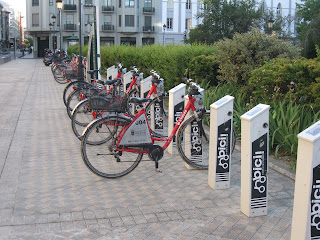It is Sunday morning here in San Sebastian, and at 7 a.m. I went looking for a cafe where I could read and have a cafe con leche. There was nothing open but a news agency on the square near our pension so I walked out to the main street. Little knots of young people were on their way home after the long night of drinking and partying. They were drunk but in the Spanish way, which means they were singing and talking loud, not stumbling and puking, but swaying.
On the main street one cafe was open. It was jammed with mostly young people, some of whom were drinking beer or brandy and some who were drinking coffee. This was not the crowd up early to read the Sunday papers. They had not been home yet.
Till the sun comes up
On Saturday night, it seems the rule is to stay out with your friends until the sun rises. At least this has seemed to be true in other places we have been, all cities and towns. They go home and then who knows when they get up. Maybe mid afternoon for the big Sunday meal.
On a work day, there are lots of people up and moving about at 7 in the morning and some are going to work, but for many people the work day seems to start about 10, with lunch from 2 to 3 or maybe longer. Then it is back to work and the evening rush hour gets going at around 7 and goes till maybe 8:30 or 9. That is a big generalization. It does seem that the whole work day is moved back about two hours.
 | ||
| School kids hold hands as they go on a little field trip. |
People work hard but in a different way. I have noticed workers in restaurants, bars and cafes who are on the job for more than 12 hours a day. The same people who served us coffee in the morning were serving us dinner that night. Lots of parents pick up their kids from school, which ends at around 1 or 1:30, and walk them home. They may take coffee breaks during the day or go out for a beer but they go back to work and are on the job later.
 |
| I just liked this picture. Spanish women on holiday in Cordoba, posing with their ice cream. |
I had heard that cursing in Spain is all about blasphemy and bodily secretions while in Mexico it is all about who is screwing whom. I can attest to the latter, having received as a going-away gift from my Mexican colleagues a dictionary, titled El chingonario, of expressions and variations on their favorite curse word, equivalent to the F-word in English. That same word is not used much in the rest of the Spanish-speaking world, but when it is it means something like bother or annoy.
To be honest, I haven’t heard a lot of cursing here in Spain except to refer to the sexual equipment of a prostitute, a favorite expression also in Bolivia. At the bullfights here, the crowd is dignified and restrained in its applause for the toreros, as though they were discriminating and hard to please. At the one Mexican bullfight I attended, in Guadalajara, the crowd was boisterous and rude throughout. Drunks shouted insults at the toreros, even the good ones, "asshole" and "dumbass" being the favorites. At the same time, the Mexicans were far more enthusiastic and applauded louder than the Spanish fans when a torero executed a series of smooth passes with the bull.
The Spanish spoken here is very different from Mexico in much the same way British English is different from American. They have different words for the same thing, just as the British call a car’s hood the bonnet, the trunk is the boot and the windshield is the windscreen. Here a ticket is billete instead of a boleto, a pool is a piscina instead of an alberca, the sidewalk is the acera and not the banqueta, and so on.
 | |
| Typical apartment block in San Sebastian, with bicycles stored on the balcony. A child was playing on the terrace on the top floor. |
 |
| The oval white sign on the left was for our pension in San Sebastian. For $50 a night, we had a small room, very nice, with armoire, tiny bathroom and excellent free wifi. |
Cities are densely packed in Spain, with lots of apartment blocks of five or six stories, and every city has large areas for pedestrians only. We have stayed in or near the historical centers, so we have had the benefit of being in the most walkable areas of Spanish towns and cities.


Suburban sprawl is starting to show itself. We took a bus ride of about 45 minutes from the city of Santander to the town of Santillana del Mar and it was noticeable that some subdivisions of individual homes had been carved into the farm fields just as you might see in any metropolitan area of the U.S. Bedroom communities. They were noticeable because they were different from most of what you see.

No comments:
Post a Comment